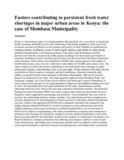| dc.description.abstract | Water is a basic human right as it is fundamental to life and death. It is a key factor in improving health, economic productivity and social well being of the human populace as both social and economic activities rely heavily on the quantity and quality of water. Despite its significance in sustaining human. livelihoods, access to water largely remains a pipe dream for many people globally and particularly in developing countries.
Like many other developing countries, provision of water has remained one of the greatest challenges for the Kenyan government to surmount. Mombasa, Kenya's second largest city has over the years borne the brunt of persistent water shortages. With a daily water demand of 180,000 cubic metres against a total supply of 40,000 cubic metres a day, the city is left with a water deficit of 140,000 cubic meters a day.
The study sought to ascertain the factors contributing to persistent fresh water shortages in major urban areas in Kenya, with Mombasa City. as its case study. Of key concern to the study was the contribution of factors such as corruption, political interference, financial constraints and staffmg, to persistent fresh water shortages in Mombasa Municipality. The survey research design was employed by the study.
The study targeted employees from Mombasa Water and Sewerage Company, the Coast Water Services Board, the Municipal Council of Mombasa, as well as water kiosk operators as its target population. Purposive and stratified sampling was used to select 89 respondents from the target institutions for the study. Questionnaires and key informant interviews were used as the main data collection instruments/methods. The statistical Package for Social Scientists (SPSS) was used to analyze data which was presented in form of frequency tables supported by percentages and narratives. Cross tabulations were also used to examine the relationships between various variables.
The study found out that corruption was a common phenomenon in the management of water resources in Mombasa; political interference was also evident in the operations of MOWASCO; financial constraints also emerged as the leading obstacle behind MOWASCO's limited investment in water infrastructure and lastly, staffing challenges such as poor motivation contributed significantly to the involvement of MOW ASCO staff in corrupt dealings.
The study concluded that corruption had contributed to persistent water shortages by denting the company's income; political interference on the other hand was responsible for the leadership vacuum in the company as evidenced by the absence of a Board of Directors; financial constraints were affecting the company's ability to invest in new water infrastructure; and finally, poor remuneration and the lack of an effective staff rewarding system had contributed to staff involvement in harmful practices such illegal water connections. | en_US |

